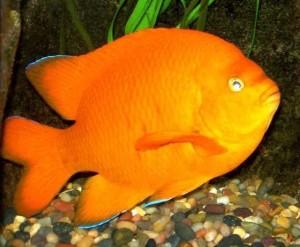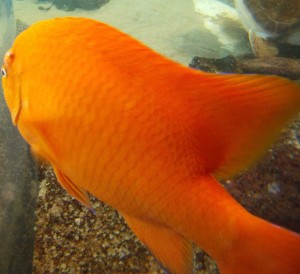The Garibaldi at the Living Coast
by Lindsay Bradshaw, Animal Care Manager
 If you have ever been out snorkeling or diving in southern California, you will notice a trend: brown fish, gray fish, black fish, another brown fish, spotted grey fish, more brown fish, et cetera, et cetera. It is a big contrast to the vibrant colors you see out on a tropical coral reef where it looks like an entire rainbow has come alive and is swimming all around you. But despite the dull color palate (a palate based on camouflage among the brown kelp and seaweed), there is one fish in southern California who didn’t get the memo and stands out among the rest of his grey and brown neighbors: the garibaldi, California’s state marine fish.
If you have ever been out snorkeling or diving in southern California, you will notice a trend: brown fish, gray fish, black fish, another brown fish, spotted grey fish, more brown fish, et cetera, et cetera. It is a big contrast to the vibrant colors you see out on a tropical coral reef where it looks like an entire rainbow has come alive and is swimming all around you. But despite the dull color palate (a palate based on camouflage among the brown kelp and seaweed), there is one fish in southern California who didn’t get the memo and stands out among the rest of his grey and brown neighbors: the garibaldi, California’s state marine fish.
 Garibaldi are bright orange. Rather than camouflage, their coloration acts to draw attention to themselves and they stand out like a traffic cone on a busy street. Their kelp forest home is one of greens and browns, so why would the garibaldi want to stand out from its surroundings? The answer lies in why all animals exhibit the colors that they do. Nature always has a reason for everything – camouflage helps animals blend in with their surroundings to avoid predation and increases their chance for survival; disruptive coloration, like the stripes on a zebra, confuse predators; advertising coloration is often a sign that the animal will do a service (so don’t eat him!), like a bright red cleaner shrimp crawling into the mouth of a predatory moray eel to feed on and clean the moray eel of parasites.
Garibaldi are bright orange. Rather than camouflage, their coloration acts to draw attention to themselves and they stand out like a traffic cone on a busy street. Their kelp forest home is one of greens and browns, so why would the garibaldi want to stand out from its surroundings? The answer lies in why all animals exhibit the colors that they do. Nature always has a reason for everything – camouflage helps animals blend in with their surroundings to avoid predation and increases their chance for survival; disruptive coloration, like the stripes on a zebra, confuse predators; advertising coloration is often a sign that the animal will do a service (so don’t eat him!), like a bright red cleaner shrimp crawling into the mouth of a predatory moray eel to feed on and clean the moray eel of parasites.
 Garibaldi have what is called “warning coloration”. It is a sign to other fish to steer clear. Garibaldi are fiercely protective of their nests and very territorial. Male garibaldi start off by picking a nice flat rock and clearing out all algae other than the desired species of red algae. The females will visit numerous nest sites before picking one to deposit her eggs in. The males are responsible for tending the nest and raising the young, a task they take very seriously. Garibaldi have been known to chase after much larger fish and even scuba divers that swim too close to their nest.
Garibaldi have what is called “warning coloration”. It is a sign to other fish to steer clear. Garibaldi are fiercely protective of their nests and very territorial. Male garibaldi start off by picking a nice flat rock and clearing out all algae other than the desired species of red algae. The females will visit numerous nest sites before picking one to deposit her eggs in. The males are responsible for tending the nest and raising the young, a task they take very seriously. Garibaldi have been known to chase after much larger fish and even scuba divers that swim too close to their nest.
When we talk about coloration, the baby garibaldi are no exception. Having a darker orange color and bright blue spots, these youngsters aren’t advertising that they are aggressive or territorial, they are advertising to the adult garibaldi that they are just babies and might not understand territory boundaries yet. A way to say ‘go easy on us… we don’t know any better’. Coloration for fish is not only a means to communicate, but a way to increase their survival. Next time you are at the Living Coast Discovery Center, see if you can find our two resident garibaldi!
 Lindsay Bradshaw is the Animal Care Manager at the Living Coast Discovery Center. She has worked for several animal-focused organizations, including Birch Aquarium at Scripps, Nature and Raptor Center of Pueblo, Maui Ocean Center, and the Vancouver Aquarium.
Lindsay Bradshaw is the Animal Care Manager at the Living Coast Discovery Center. She has worked for several animal-focused organizations, including Birch Aquarium at Scripps, Nature and Raptor Center of Pueblo, Maui Ocean Center, and the Vancouver Aquarium.
